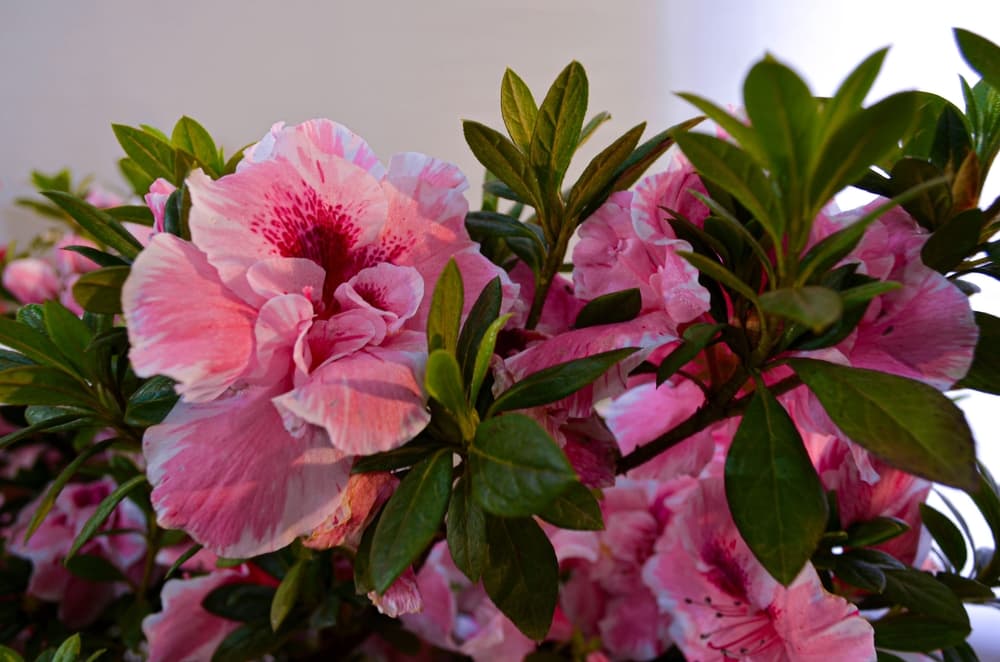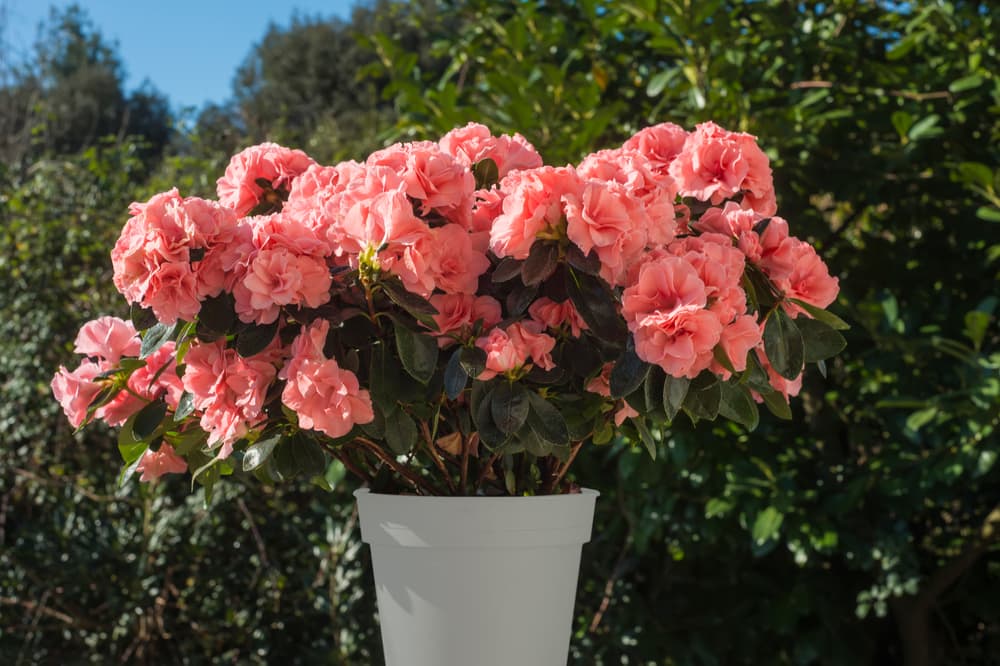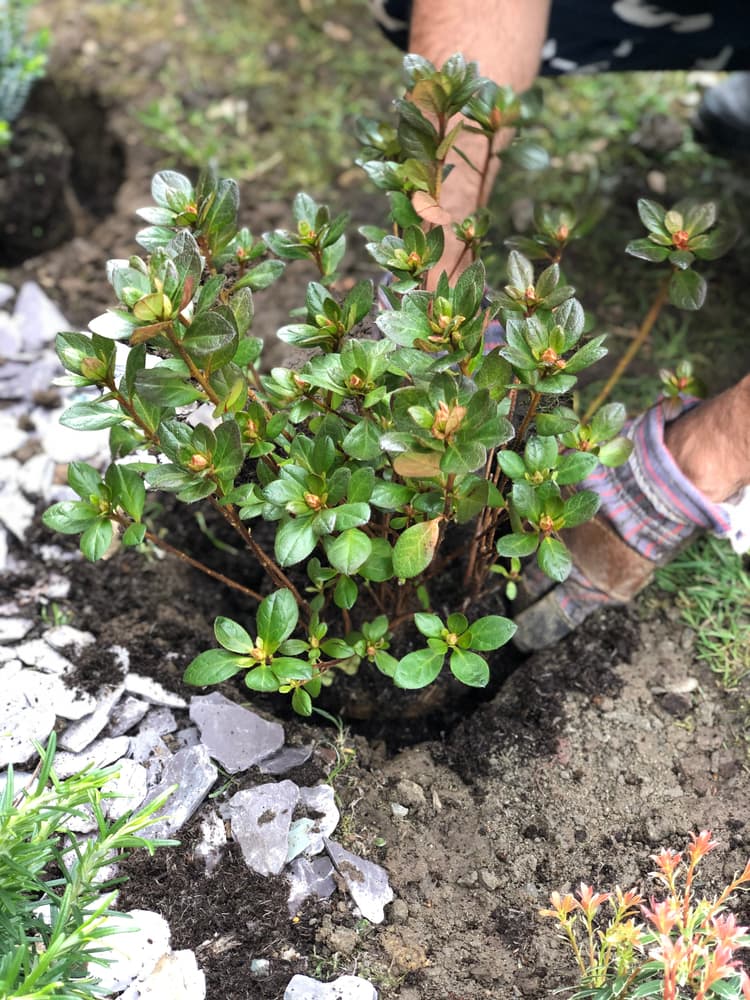
Elizabeth is a Permaculture Garden Designer, Sustainability Consultant and Professional Writer, working as an advocate for positive change. She graduated from the University of St. Andrews with an MA in English and Philosophy and obtained a Diploma in Applied Permaculture Design from the Permaculture Association.
Reviewed By COLIN SKELLY

Colin is a Horticulturist and Horticultural Consultant with experience in a range of practical and managerial roles across heritage, commercial and public horticulture. He holds the Royal Horticultural Society’s Master of Horticulture award and has a particular interest in horticultural ecology and naturalistic planting for habitat and climate resilience.
IN THIS GUIDE
Rhododendron japonicum is a compact Azalea, in the Rhododendron family which can work well in beds or border, or containers with acidic conditions.
Rhododendron japonicum, known as Japanese Azalea, is a flowering shrub – usually evergreen – with a relatively compact form, glossy deep green leaves and flowers which come in a wide range of colours.
It is a type of evergreen Rhododendron (though some cultivars can be semi-evergreen and lose leaves in cold winters), within the Ericaceae plant family.1Rhododendron – Azalea or Rhododendron. (n.d.). Plant Facts. Retrieved March 10, 2023, from https://plantfacts.osu.edu/pdf/0247-943xx.pdf
Overview
| Botanical Name | Rhododendron japonicum |
| Common Name(s) | Japanese Azalea |
| Plant Type | Shrub / Houseplant |
| Native Area | Japan |
| Hardiness Rating | Often H4 |
| Foliage | Lobed, evergreen leaves |
| Flowers | Various hues, commonly pink |
| When To Sow | March, April, May, June, September, October |
| Flowering Months | March, April |
| When To Prune | April, May |
Sunlight
Preferred
Full Sun or Partial Shade
Exposure
Sheltered
Size
Height
0.1 – 1M
Spread
0.1 – 1M
Bloom Time
April – June
Soil
Preferred
Chalk, loam, sand
Moisture
Moist but well-drained
pH
Acidic
These plants have smaller leaves than deciduous Rhododendrons.

Azaleas have been cultivated for centuries and more than 10,000 vibrant cultivars have been created, which means that there are plenty of options to consider when choosing one of these plants for your garden.2Azalea Society of America. (2018, August 14). Learn about azaleas. Retrieved March 10, 2023, from https://www.azaleas.org/about-azaleas/
Azaleas are categorised under two sub-genera – Tsutsusi and Pentanthera. Japanese evergreen Azalea fall within the former sub-genus.3Rhododendron and Azalea Classification Information. (n.d.). The American Rhododendron Society. Retrieved March 10, 2023, from https://www.rhododendron.org/classification.htm

Azaleas are important in Japanese culture and Azalea festivals take place across the country each year, which are attended by many visitors.
The plants are a common sight in Japanese (and Japanese-inspired) gardens around the world.
R. japonicum is sometimes also used for bonsai, carefully and delicately trained – and sometimes used as container plants or even houseplants.
Why Grow R. japonicum?
Rhododendron japonicum is ideal for a low-maintenance garden.
They are one of the most vibrant spring-flowering shrubs that can be grown in the UK, and provide their beautiful blooms for several weeks in April, May or June.

Because of their spring flowering, they are also popular gifts for Mother’s Day and Easter.
These are a popular range of shrubs for acid-soil gardens, since these are ericaceous plants that like a more acidic soil pH.
They can help you make the most of a garden with acidic soil conditions.
Even where there is not acidic soil, these small shrubs are pretty easy to grow in pots.
Japanese Azalea Varieties
There is a huge range of Japanese Azaleas to choose from. Some popular types to consider include:
‘Kurume’

Semi-dwarf Azalea hybrids which bloom prolifically.
‘Satsuki’

Compact Azaleas which bloom towards the end of spring.
These Azaleas have dwarf tree shape, with beautiful gnarled trunks.
They were originally hybrids of Rhododendron indicum and Rhododendron eriocarpum, and have been cultivated in Japan for centuries, but in the UK only since the beginning of the 20th Century.4Kennedy, C. (2022, June 28). Satsuki Evergreen Azaleas Extend the Blooming Season of the Genus Rhododendron. Seattle Japanese Garden. Retrieved March 10, 2023, from https://www.seattlejapanesegarden.org/blog/2022/6/28/with-their-elegant-late-may-and-june-flowers-satsuki-evergreen-azaleas-extend-the-blooming-season-of-the-genus-rhododendron
These are not particularly hardy, but can be grown outdoors in milder parts of the UK, or as container plants to take indoors in winter in cooler regions.
Encore Azaleas

Bloom from spring right through the summer months.
These were developed by Robert C Lee in Louisiana.5Borden, J. (2021, September 1). Meet the Man Behind the South’s Iconic Encore Azalea. Southern Living. Retrieved March 10, 2023, from https://www.southernliving.com/garden/flowers/encore-azalea-buddy-lee
Gartrell & Robin Hill Hybrid Azaleas

These are a group of larger flowered hybrids developed by Robert Derby Gartrell in the late 20th Century.6A Guide to the Notebooks and Papers of Robert Gartrell. (n.d.). University of Virginia Library. Retrieved March 10, 2023, from https://ead.lib.virginia.edu/vivaxtf/view?docId=uva-sc/viu04020.xml
Some interesting cultivars to consider include:
- ‘Hot Shot’ – variegated leaves and striking red flowers.
- ‘Silver Queen’ – variegated leaves and bright pink blooms.
- ‘Summer Sun’ – Satsuki variety, rich red flowers.
- ‘Robleza’ – Encore type, deep, intense red blooms.
- ‘Robles’ – Encore, purple flecked lilac flowers.
- R. x amoenum – Kurume variety, magenta-purple flowers, red autumn foliage.
- ‘Hino Crimson’ – RHS AGM, small, deep red flowers.
- ‘Mother’s Day’ – RHS AGM, bright red blooms.
- ‘Addy Wery’ – RHS AGM, deep, rich red flowering.
- ‘Iro Hayama’ – RHS AGM, white flowers with graduation to lavender or mauve.
Though of course there are many, many more Japanese Azaleas to consider.
Where To Grow Japanese Azalea
Japanese Azalea is definitely a good houseplant to consider growing in a container inside your home.
Many more compact cultivars are perfect for container growing, indoors, or outdoors with winter protection.

However, many Japanese Azaleas can also be a great choice for a UK garden.
Many cultivars are H4 hardy, but take note that there are many Azaleas which are not as hardy and which are only options for outdoors cultivation in very mild and protected southern gardens.
Hardier cultivars will grow well in a fertile, rich, sandy or loamy soil which is moist and relatively moisture-retentive, without becoming waterlogged.

They will thrive in a sheltered spot, in partial shade or full sun.
Whether it is best to grow R. japonicum in full sun or partial shade will depend on your location, and the type and cultivar you have chosen to grow.
Of course, the most important thing to remember is that, like other ericaceous plants, R. japonicum does require acidic soil.
The optimal pH is between 5 and 6 for most Azaleas.

Japanese Azaleas can work well in a planting scheme alongside other Azaleas, Rhododendrons, and Camellias.
By selecting cultivars carefully you can enjoy blooms over a much longer period – some can even work well as hedges.
With Japanese Acers and other Japanese plants which like acidic conditions, they can be perfect for a Japanese-inspired garden.
Planting
When planting R. japonicum, it is important to take care not to damage the roots.

It is also important to plant the shrubs at the same level that they were at in their previous pot.
Avoid planting them too deeply as they are intolerant of this.
The top of the root ball should be above the soil – take care to ensure that this is not buried or the Azalea may fail to thrive or even die.

If growing Japanese Azaleas in containers, make sure you choose a container that is of a sufficient size, and one which allows free drainage.
Place crocks at the base to make sure water can pass through freely.
Of course, you also need to make sure that you fill your container with ericaceous compost.
Plant Care Guidelines

A. japonicas are varied plants and some are much easier to care for and lower maintenance than others.
Once established, hardy types in your garden can be more or less left to their own devices.
Less hardy types grown in containers, or indoors, will require a little more care.
Watering
Once established, most Japanese Azaleas can be relatively drought-tolerant.
However, it is very important to water well during establishment, and to make sure that the soil (or potting mix in containers) does not dry out during dry spells.
When Azaleas are subjected to drought, they tend not to flower as well – since they are shallow-rooted, they do need the soil to be kept moist.
“Rhododendron japonicum, when established, can tolerate periods of dry weather but can take some time to recover from drought,” shares Colin Skelly, Horticultural Consultant.

“I focus on the planting position, such as avoiding areas that dry out in summer or providing dappled shade (but not dry shade).
“Just as important is a thick layer of annual mulch (being careful not to mound against the stem) to hold moisture close to the shallow root system.
“Also, I don’t clear away leaf litter as this helps to create a moisture-holding soil layer where the roots need it.”
Remember that you will have to water container-grown plants more frequently than those grown in the ground.
Mulching
As Colin highlights above, it is a very good idea to mulch well around your plants to protect the shallow roots of these shrubs and reduce moisture loss.

Choose an ericaceous mulch such as pine bark or pine needles to do so.
Mulching will also provide all the fertility Japanese Azaleas need.
It is not usually necessary to provide any other fertiliser for these plants.
In fact, fertilising too much can be counterproductive and these shrubs may not perform as well if you do so.
Pruning
Azaleas typically only need light pruning and Japanese Azaleas may not really need to be pruned at all.
As mentioned above, however, some Azaleas are used as bonsai, and trained and trimmed into ornamental, decorative forms.
If light pruning is required, this should typically be undertaken just after the end of the flowering period.
Make sure you do not prune after buds for next year’s flowers begin to form, as this would mean fewer flowers the following year.
There is more to discover about Japanese Azaleas, but this guide should help you with the basics of choosing and growing these beautiful flowering plants.
References
- 1Rhododendron – Azalea or Rhododendron. (n.d.). Plant Facts. Retrieved March 10, 2023, from https://plantfacts.osu.edu/pdf/0247-943xx.pdf
- 2Azalea Society of America. (2018, August 14). Learn about azaleas. Retrieved March 10, 2023, from https://www.azaleas.org/about-azaleas/
- 3Rhododendron and Azalea Classification Information. (n.d.). The American Rhododendron Society. Retrieved March 10, 2023, from https://www.rhododendron.org/classification.htm
- 4Kennedy, C. (2022, June 28). Satsuki Evergreen Azaleas Extend the Blooming Season of the Genus Rhododendron. Seattle Japanese Garden. Retrieved March 10, 2023, from https://www.seattlejapanesegarden.org/blog/2022/6/28/with-their-elegant-late-may-and-june-flowers-satsuki-evergreen-azaleas-extend-the-blooming-season-of-the-genus-rhododendron
- 5Borden, J. (2021, September 1). Meet the Man Behind the South’s Iconic Encore Azalea. Southern Living. Retrieved March 10, 2023, from https://www.southernliving.com/garden/flowers/encore-azalea-buddy-lee
- 6A Guide to the Notebooks and Papers of Robert Gartrell. (n.d.). University of Virginia Library. Retrieved March 10, 2023, from https://ead.lib.virginia.edu/vivaxtf/view?docId=uva-sc/viu04020.xml

